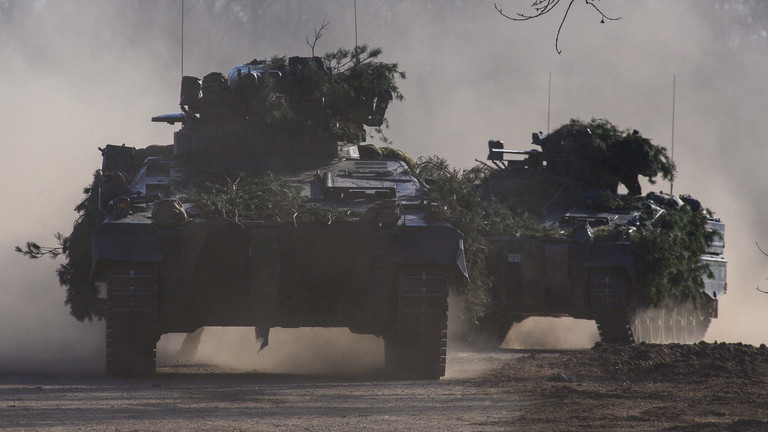©Global Look Press/Klaus-Dietmar Gabbert
German-made heavy armor pieces are rolling through the fields of Russia’s Kursk Region again, some 80 years since one of the biggest battles of WWII in the same area, Bild wrote on Thursday, reporting on Kiev’s cross-border incursion.
The German tabloid, citing videos posted online, said that several Marder infantry fighting vehicles (IFVs) have been spotted among the equipment used by the Ukrainian military in its offensive, launched early on Tuesday. The media outlet pointed to footage published by the Russian Defense Ministry, which shows IFVs being hit with Russian kamikaze drones.
Thursday morning, the ministry published a clip showing the destruction of at least three Marder vehicles by Russian Lancet drones, among other strikes on Ukrainian military equipment. The armor pieces were hit while moving along dirt roads and through a wooded area.
Posting on X (formerly, Twitter), Bild journalist Julian Ropcke said all three Marders “fell victim” to Russian strikes just a few kilometers from the border – as the Ukrainian forces had sent them into battle “without adequate air defense.”
The news of German-made weapons being used in an attack on Russia’s internationally recognized Russian territory has prompted a mixed reaction in Germany. The head of the German parliament’s Defense Committee, Markus Faber, stated he had no issues with the development. Any weapons handed over to Kiev cease to be German and become Ukrainian ones, he told the Funke Media Group. He also described the territory of both Ukraine and Russia as a “war zone.”
“This is a highly dangerous development,” said Sahra Wagenknecht, the head of the newly formed BSW Party and a former Left Party leader. Chancellor Olaf Scholz should call the Ukrainian leadership and “demand that no German weapons be used in [attacks] on the Russian territory,” she added. Back in 1943, Soviet troops clashed with the Nazi forces on the fields of the Kursk Region in what has since become known as the Battle of Kursk. It was one of the deadliest episodes of World War II and one of the largest tank battles in history.
Nazi Germany sought to achieve victory at the time by fielding its then brand-new armor pieces, including Panther and Tiger tanks as well as Ferdinand tank destroyers. The battle involved thousands of tanks on both sides, ended with the Soviet forces inflicting a defeat on the Nazi troops.
Up to 1,000 Ukrainian soldiers have been involved in the incursion into Kursk Region this week, supported by armor that included several US-made Stryker armored fighting vehicles, as well as artillery and drones, the Russian Defense Ministry has said.
Kiev’s forces have lost some 660 soldiers and 82 armor pieces, including eight tanks, 12 armored personnel carriers and six infantry fighting vehicles since the start of their operation, according to estimates provided by the ministry on Thursday. Moscow’s forces have stalled the Ukrainian troops’ offensive and prevented them from getting deeper into the region, the Russian authorities said.
WATCH Russia drop high-precision bombs on Ukrainian incursion forces in Kursk
The Russian Defense Ministry has released drone footage showing glide bombs hitting Ukrainian forces during their incursion into Russia’s Kursk Region.
The video showed two strikes using FAB-500 bombs – a munition initially designed to be unguided – fitted with a modern Universal Correction and Guidance Module winged upgrade kit, the Russian Defense Ministry said. Two blasts in a patch of woodland next to a road can be seen in the collated drone footage, seen from two different angles. The munitions were deployed from supersonic multifunctional Su-34 fighter-bombers, which carried out strikes against Ukrainian forces and their military equipment, according to the statement.
“Having received confirmation from reconnaissance that the targets had been destroyed, the crews returned safely to the deployment airfield,” the Defense Ministry said. Russian glide bombs have seen more extensive use in the Ukraine conflict in the past year, with Kiev’s sources often describing them as “devastating” in their statements to Western media.
Early on Tuesday, Ukrainian forces launched a cross-border incursion into Russia’s Kursk Region. The Ukrainian leadership said on Thursday that one of the objectives of the assault is to sow “fear” into the hearts of the Russian population, in order to lower support for their government and eke out a stronger negotiating position.
Russian President Vladimir Putin dubbed the push as a “large-scale provocation,” accusing Kiev of conducting “indiscriminate strikes” on civilians, civilian buildings and ambulances. Multiple videos circulating online in the past two days appear to show Ukrainian troops firing on civilian cars.
According to an early statement from the Russian Defense Ministry, Kiev’s assault was carried out by forces numbering up to a thousand, supported by tanks and artillery. A ministry spokesman later reported that Kiev’s advance had been stopped.
Ukrainian forces lost up to 400 service members dead or wounded, as well as 32 units of heavy equipment in the Kursk Region over the course of the day, a ministry statement said on Thursday evening. In total, Kiev has lost more than 660 troops and 82 pieces of heavy equipment in the incursion, it added.
IAEA does not see threats to Kursk power plant nuclear safety
The International Atomic Energy Agency (IAEA) does not see reasons for concerns regarding nuclear safety of the Kursk Nuclear Power Plant amid the attack of the Ukrainian army against the Kursk Region.
"The IAEA is following reports about recent developments and has channels of communication open to both sides of the conflict. At this point there is no reason for concern with regard to nuclear safety and security," agency’s press service told TASS.
"IAEA Director General Rafael Mariano Grossi reiterates that all nuclear power plants, regardless of where they are situated, should never be a target of an armed attack," the press service added.
The large-scale attack of the Ukrainian armed forces against the Kursk Region was launched on August 6.



No comments:
Post a Comment